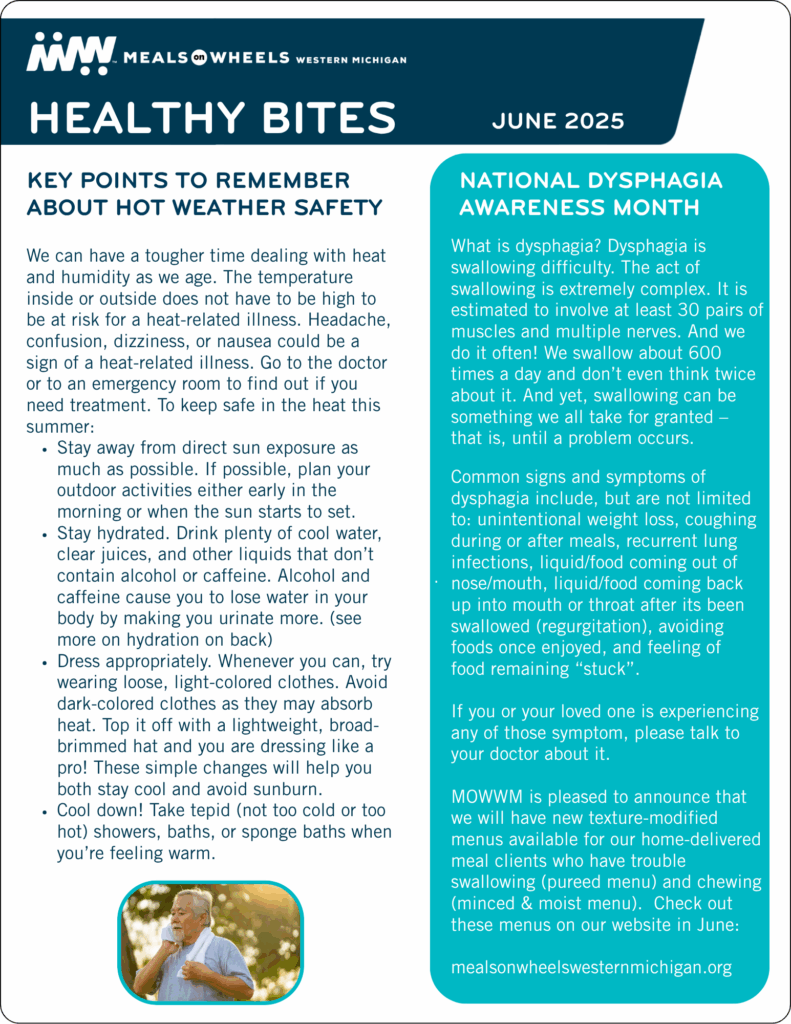Key points to remember about hot weather safety
We can have a tougher time dealing with heat and humidity as we age. The temperature inside or outside does not have to be high to be at risk for a heat-related illness. Headache, confusion, dizziness, or nausea could be a sign of a heat-related illness. Go to the doctor or to an emergency room to find out if you need treatment.
To keep safe in the heat this summer:
- Stay away from direct sun exposure as much as possible. If possible, plan your outdoor activities either early in the morning or when the sun starts to set.
- Stay hydrated. Drink plenty of cool water, clear juices, and other liquids that don’t contain alcohol or caffeine. Alcohol and caffeine cause you to lose water in your body by making you urinate more. (see more on hydration on back)
- Dress appropriately. Whenever you can, try wearing loose, light-colored clothes. Avoid dark-colored clothes as they may absorb heat. Top it off with a lightweight, broad-brimmed hat and you are dressing like a pro! These simple changes will help you both stay cool and avoid sunburn.
- Cool down! Take tepid (not too cold or too hot) showers, baths, or sponge baths when you’re feeling warm.
Are you at Risk for diabetes?
Learn about the Diabetes Prevention Program from the National Kidney Foundation of Michigan or you can call the National Kidney Foundation of Michigan (NKFM) at 1-800-482-1455
National Dysphagia Awareness Month
What is dysphagia? Dysphagia is swallowing difficulty. The act of swallowing is extremely complex. It is estimated to involve at least 30 pairs of muscles and multiple nerves. And we do it often! We swallow about 600 times a day and don’t even think twice about it. And yet, swallowing can be something we all take for granted – that is, until a problem occurs. Common signs and symptoms of dysphagia include, but are not limited to: unintentional weight loss, coughing during or after meals, recurrent lung infections, liquid/food coming out of nose/mouth, liquid/food coming back up into mouth or throat after its been swallowed (regurgitation), avoiding foods once enjoyed, and feeling of
food remaining “stuck.”
If you or your loved one is experiencing any of those symptom, please talk to your doctor about it.
MOWWM is pleased to announce that we will have new texture-modified menus available for our home-delivered meal clients who have trouble swallowing (pureed menu) and chewing (minced & moist menu).
Check out these menus on our website in June.
Super fluffy banana Smoothie
Prep Time: 5 Min | Serves: 1
Ingredients
- 2 cups ice
- 1 frozen banana
- 1/2 cup milk
- 1 scoop protein powder
- 2 tsp vanilla pudding mix
Directions
-
Place all ingredients in a large blender and blend until smooth. Be sure to blend this smoothie for an extra long time. You can substitute any type of pudding mix flavor your like. You can also omit the pudding mix if you don’t have it on hand.
colleenchristensennutrition.com
There are simple steps you can take to get the water your body craves:
- Choose foods with high water content. If you have trouble drinking fluids, try including water-rich foods like cucumbers, watermelon, lettuce, strawberries, tomatoes and celery.
- Keep water with you, always. Having hydration at your fingertips can make it easier to get the right amount of fluids. Carry a refillable water bottle with you wherever you go.
- Avoid or reduce your alcohol intake. Alcohol is a diuretic, which means it prompts your body to remove fluids from your bloodstream.
- Change it up. Pure, clean water is the best way to stay hydrated. But let’s face it—drinking plain water all day can get boring! Try jazzing up your H2O by adding slices of fresh lemon, apple, cucumber or berries.
- Build hydration into your routine. Making it a point to drink water at certain times each day can help transform it into a healthy habit.





